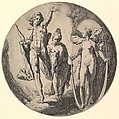The Fourth Day (Dies IV): The Creation of Day and Night, from "The Creation of the World"
Jan Muller Netherlandish
After Hendrick Goltzius Netherlandish
Publisher Hendrick Goltzius Netherlandish
Not on view
In 1589 Jan Muller, son of the Amsterdam book printer, engraver, and publisher, was a member of or working in Hendrick Goltzius’s workshop in Haarlem. During that time, he engraved a series of prints depicting the creation of the world after designs by Goltzius, the premier draftsman and printmaker in the northern Netherlands. Although some preliminary sketches for the series still exist, the finished designs are now lost.
The series itself is extraordinary. Rather than following the centuries old traditional representations of the seven days of creation, based on the Book of Genesis, Goltzius looked instead to classical mythology for his imagery. It is often suggested that he was inspired by Ovid, the first century Latin poet, who describes the creation at the beginning of The Metamorphoses, his long poem about the gods and humankind.
Like the engraving of Day One, this composition uses a handsome couple to symbolize light and darkness, but it draws more closely on specific elements from classical mythology. At the left is Apollo the Sun God, recognizable by his bow and arrows and his wreath, and he is attended by a woman with a sundial on her head, an unusual representation of daytime. At the right is Artemis, the Goddesss of the Moon, standing on a large crescent moon and with a tiny crescent in her hair. Behind her is the figure of Night, portrayed as a Black woman and nearly identical with the figure of Darkness in Day One.
This image cannot be enlarged, viewed at full screen, or downloaded.


